UGB107 Introduction to Business Management - Alternative Assessment
VerifiedAdded on 2023/01/09
|13
|3580
|64
Report
AI Summary
This individual project report for the UGB107 Introduction to Business Management module analyzes various aspects of business operations and strategy. Part B focuses on the external business environment, employing PESTLE analysis to examine political, economic, social, technological, legal, and environmental factors affecting Tesco, followed by an application of Porter's Five Forces to assess competitive dynamics. Part A delves into management theory, specifically describing and evaluating Mintzberg's theory of management roles and how it complements traditional task-based approaches. Part C explores corporate responsibility and national culture, examining organizational practices to promote and monitor corporate responsibility, providing examples of corporate malpractice and philanthropic behavior, and applying Hofstede's five dimensions of national culture to understand cultural influences on business. The report aims to provide a comprehensive understanding of these key business concepts and their practical applications.
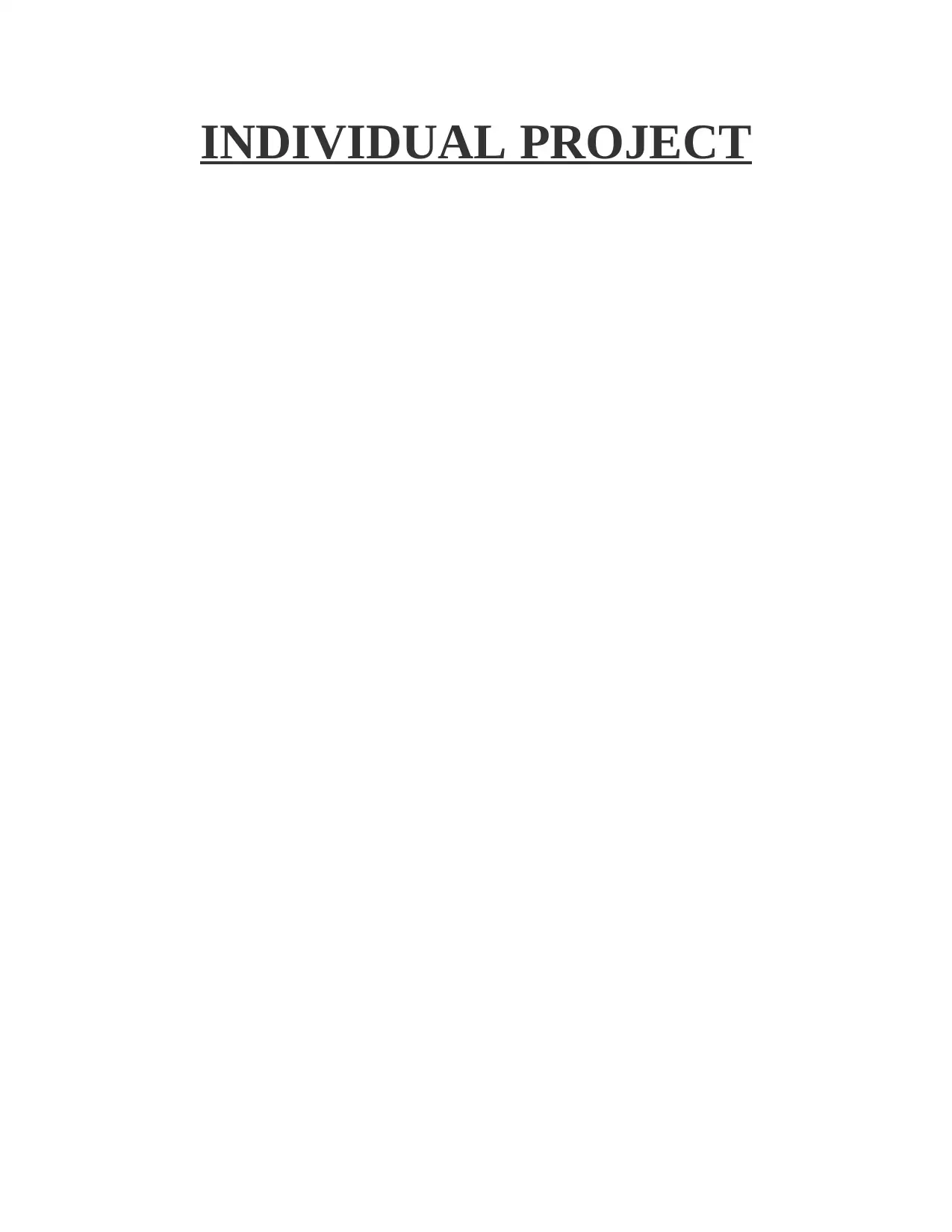
INDIVIDUAL PROJECT
Paraphrase This Document
Need a fresh take? Get an instant paraphrase of this document with our AI Paraphraser
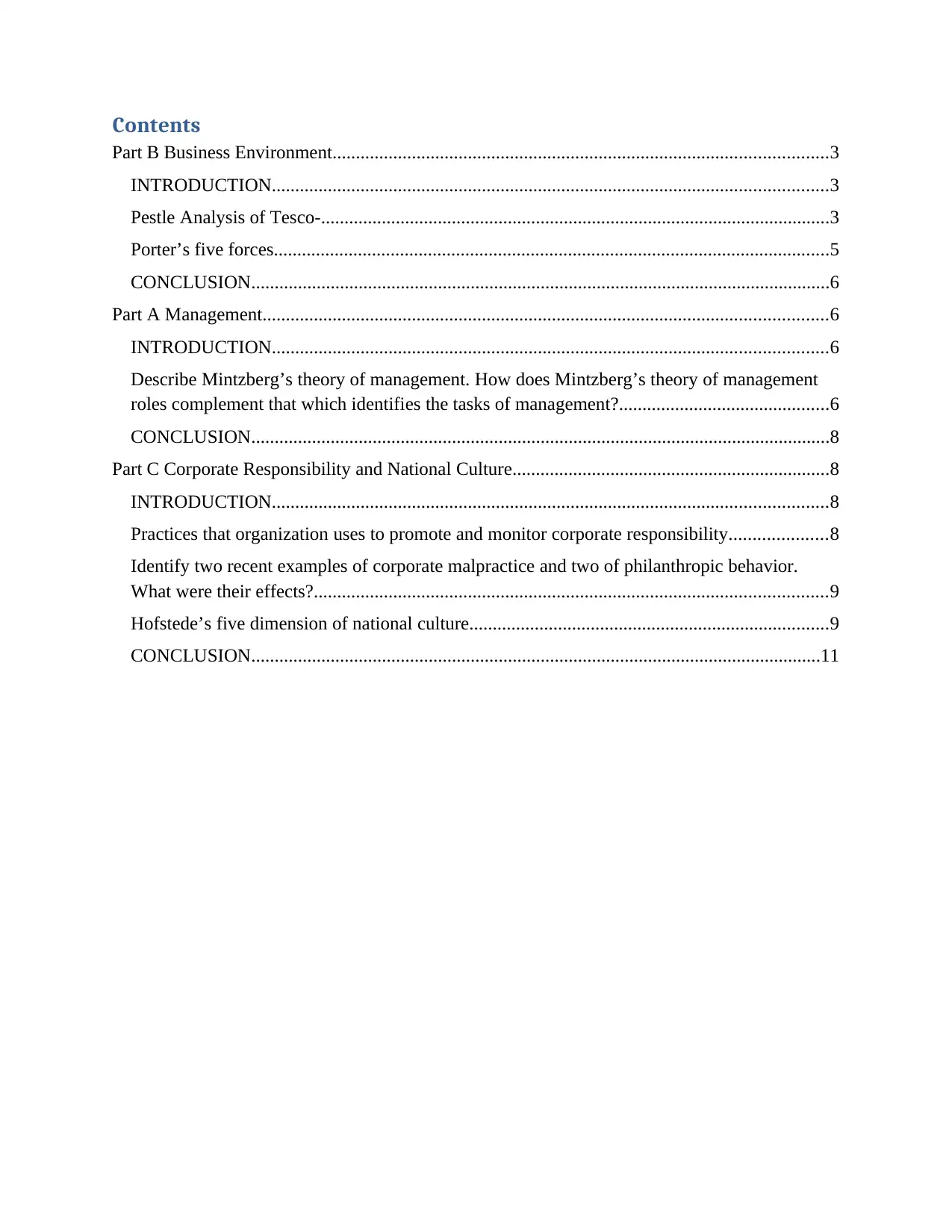
Contents
Part B Business Environment..........................................................................................................3
INTRODUCTION.......................................................................................................................3
Pestle Analysis of Tesco-.............................................................................................................3
Porter’s five forces.......................................................................................................................5
CONCLUSION............................................................................................................................6
Part A Management.........................................................................................................................6
INTRODUCTION.......................................................................................................................6
Describe Mintzberg’s theory of management. How does Mintzberg’s theory of management
roles complement that which identifies the tasks of management?.............................................6
CONCLUSION............................................................................................................................8
Part C Corporate Responsibility and National Culture....................................................................8
INTRODUCTION.......................................................................................................................8
Practices that organization uses to promote and monitor corporate responsibility.....................8
Identify two recent examples of corporate malpractice and two of philanthropic behavior.
What were their effects?..............................................................................................................9
Hofstede’s five dimension of national culture.............................................................................9
CONCLUSION..........................................................................................................................11
Part B Business Environment..........................................................................................................3
INTRODUCTION.......................................................................................................................3
Pestle Analysis of Tesco-.............................................................................................................3
Porter’s five forces.......................................................................................................................5
CONCLUSION............................................................................................................................6
Part A Management.........................................................................................................................6
INTRODUCTION.......................................................................................................................6
Describe Mintzberg’s theory of management. How does Mintzberg’s theory of management
roles complement that which identifies the tasks of management?.............................................6
CONCLUSION............................................................................................................................8
Part C Corporate Responsibility and National Culture....................................................................8
INTRODUCTION.......................................................................................................................8
Practices that organization uses to promote and monitor corporate responsibility.....................8
Identify two recent examples of corporate malpractice and two of philanthropic behavior.
What were their effects?..............................................................................................................9
Hofstede’s five dimension of national culture.............................................................................9
CONCLUSION..........................................................................................................................11
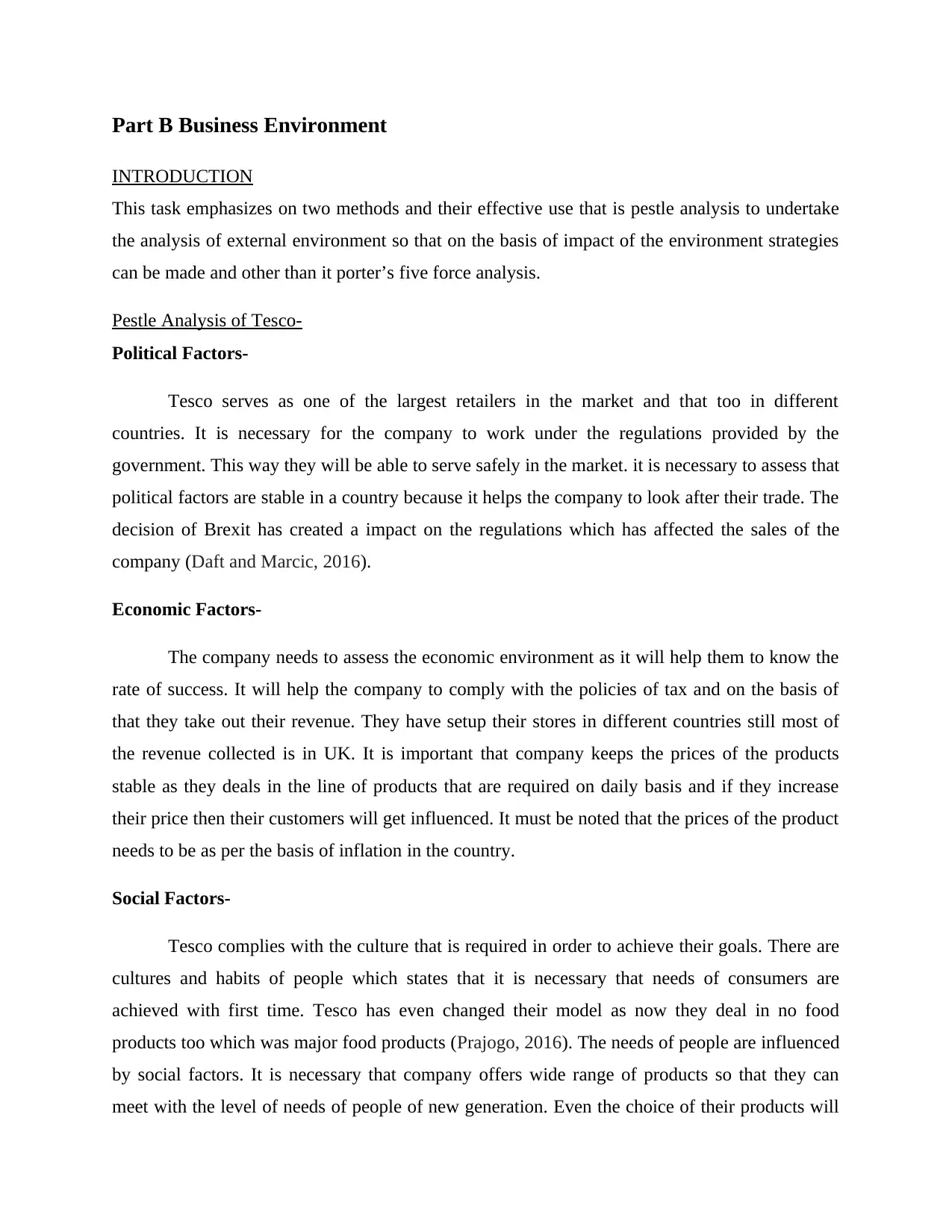
Part B Business Environment
INTRODUCTION
This task emphasizes on two methods and their effective use that is pestle analysis to undertake
the analysis of external environment so that on the basis of impact of the environment strategies
can be made and other than it porter’s five force analysis.
Pestle Analysis of Tesco-
Political Factors-
Tesco serves as one of the largest retailers in the market and that too in different
countries. It is necessary for the company to work under the regulations provided by the
government. This way they will be able to serve safely in the market. it is necessary to assess that
political factors are stable in a country because it helps the company to look after their trade. The
decision of Brexit has created a impact on the regulations which has affected the sales of the
company (Daft and Marcic, 2016).
Economic Factors-
The company needs to assess the economic environment as it will help them to know the
rate of success. It will help the company to comply with the policies of tax and on the basis of
that they take out their revenue. They have setup their stores in different countries still most of
the revenue collected is in UK. It is important that company keeps the prices of the products
stable as they deals in the line of products that are required on daily basis and if they increase
their price then their customers will get influenced. It must be noted that the prices of the product
needs to be as per the basis of inflation in the country.
Social Factors-
Tesco complies with the culture that is required in order to achieve their goals. There are
cultures and habits of people which states that it is necessary that needs of consumers are
achieved with first time. Tesco has even changed their model as now they deal in no food
products too which was major food products (Prajogo, 2016). The needs of people are influenced
by social factors. It is necessary that company offers wide range of products so that they can
meet with the level of needs of people of new generation. Even the choice of their products will
INTRODUCTION
This task emphasizes on two methods and their effective use that is pestle analysis to undertake
the analysis of external environment so that on the basis of impact of the environment strategies
can be made and other than it porter’s five force analysis.
Pestle Analysis of Tesco-
Political Factors-
Tesco serves as one of the largest retailers in the market and that too in different
countries. It is necessary for the company to work under the regulations provided by the
government. This way they will be able to serve safely in the market. it is necessary to assess that
political factors are stable in a country because it helps the company to look after their trade. The
decision of Brexit has created a impact on the regulations which has affected the sales of the
company (Daft and Marcic, 2016).
Economic Factors-
The company needs to assess the economic environment as it will help them to know the
rate of success. It will help the company to comply with the policies of tax and on the basis of
that they take out their revenue. They have setup their stores in different countries still most of
the revenue collected is in UK. It is important that company keeps the prices of the products
stable as they deals in the line of products that are required on daily basis and if they increase
their price then their customers will get influenced. It must be noted that the prices of the product
needs to be as per the basis of inflation in the country.
Social Factors-
Tesco complies with the culture that is required in order to achieve their goals. There are
cultures and habits of people which states that it is necessary that needs of consumers are
achieved with first time. Tesco has even changed their model as now they deal in no food
products too which was major food products (Prajogo, 2016). The needs of people are influenced
by social factors. It is necessary that company offers wide range of products so that they can
meet with the level of needs of people of new generation. Even the choice of their products will
⊘ This is a preview!⊘
Do you want full access?
Subscribe today to unlock all pages.

Trusted by 1+ million students worldwide
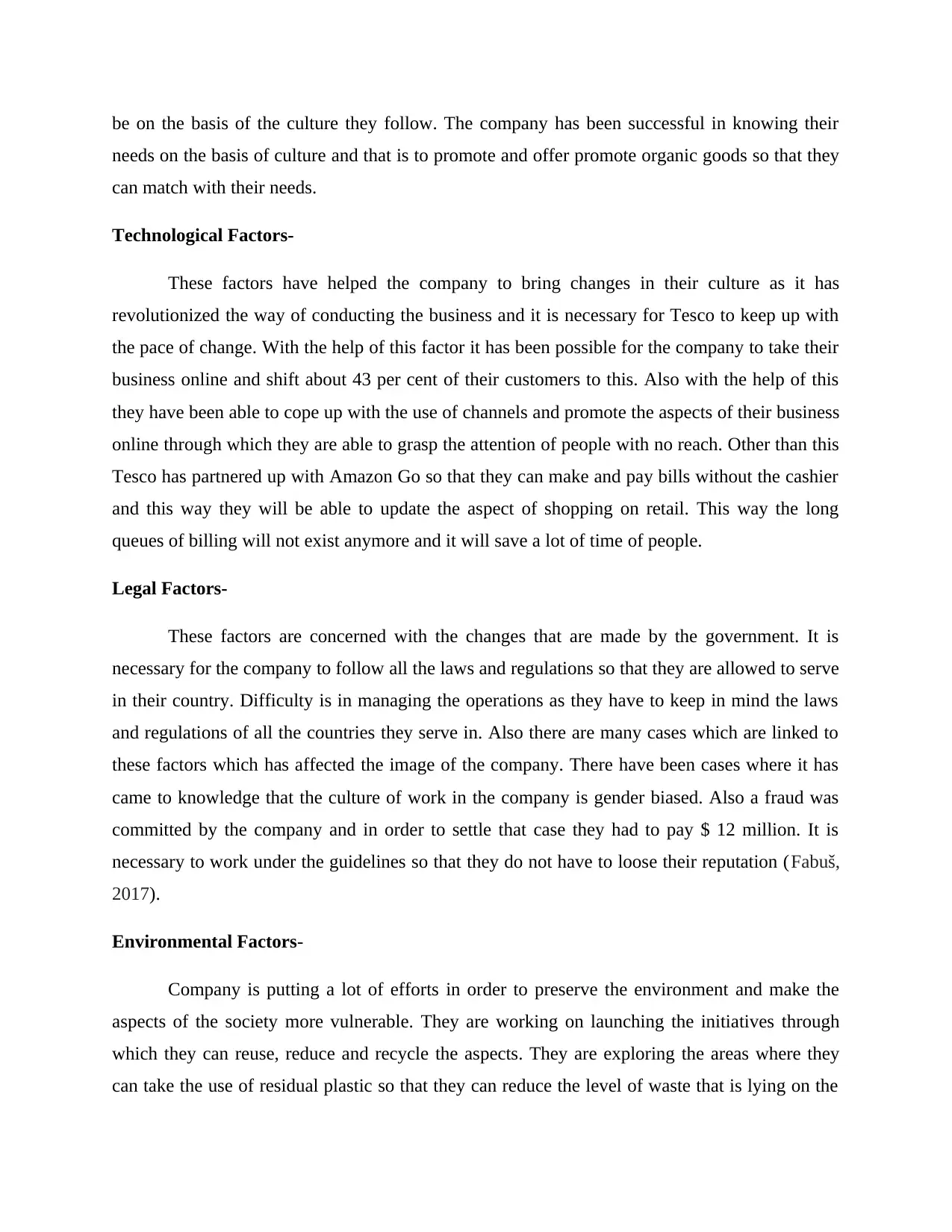
be on the basis of the culture they follow. The company has been successful in knowing their
needs on the basis of culture and that is to promote and offer promote organic goods so that they
can match with their needs.
Technological Factors-
These factors have helped the company to bring changes in their culture as it has
revolutionized the way of conducting the business and it is necessary for Tesco to keep up with
the pace of change. With the help of this factor it has been possible for the company to take their
business online and shift about 43 per cent of their customers to this. Also with the help of this
they have been able to cope up with the use of channels and promote the aspects of their business
online through which they are able to grasp the attention of people with no reach. Other than this
Tesco has partnered up with Amazon Go so that they can make and pay bills without the cashier
and this way they will be able to update the aspect of shopping on retail. This way the long
queues of billing will not exist anymore and it will save a lot of time of people.
Legal Factors-
These factors are concerned with the changes that are made by the government. It is
necessary for the company to follow all the laws and regulations so that they are allowed to serve
in their country. Difficulty is in managing the operations as they have to keep in mind the laws
and regulations of all the countries they serve in. Also there are many cases which are linked to
these factors which has affected the image of the company. There have been cases where it has
came to knowledge that the culture of work in the company is gender biased. Also a fraud was
committed by the company and in order to settle that case they had to pay $ 12 million. It is
necessary to work under the guidelines so that they do not have to loose their reputation (Fabuš,
2017).
Environmental Factors-
Company is putting a lot of efforts in order to preserve the environment and make the
aspects of the society more vulnerable. They are working on launching the initiatives through
which they can reuse, reduce and recycle the aspects. They are exploring the areas where they
can take the use of residual plastic so that they can reduce the level of waste that is lying on the
needs on the basis of culture and that is to promote and offer promote organic goods so that they
can match with their needs.
Technological Factors-
These factors have helped the company to bring changes in their culture as it has
revolutionized the way of conducting the business and it is necessary for Tesco to keep up with
the pace of change. With the help of this factor it has been possible for the company to take their
business online and shift about 43 per cent of their customers to this. Also with the help of this
they have been able to cope up with the use of channels and promote the aspects of their business
online through which they are able to grasp the attention of people with no reach. Other than this
Tesco has partnered up with Amazon Go so that they can make and pay bills without the cashier
and this way they will be able to update the aspect of shopping on retail. This way the long
queues of billing will not exist anymore and it will save a lot of time of people.
Legal Factors-
These factors are concerned with the changes that are made by the government. It is
necessary for the company to follow all the laws and regulations so that they are allowed to serve
in their country. Difficulty is in managing the operations as they have to keep in mind the laws
and regulations of all the countries they serve in. Also there are many cases which are linked to
these factors which has affected the image of the company. There have been cases where it has
came to knowledge that the culture of work in the company is gender biased. Also a fraud was
committed by the company and in order to settle that case they had to pay $ 12 million. It is
necessary to work under the guidelines so that they do not have to loose their reputation (Fabuš,
2017).
Environmental Factors-
Company is putting a lot of efforts in order to preserve the environment and make the
aspects of the society more vulnerable. They are working on launching the initiatives through
which they can reuse, reduce and recycle the aspects. They are exploring the areas where they
can take the use of residual plastic so that they can reduce the level of waste that is lying on the
Paraphrase This Document
Need a fresh take? Get an instant paraphrase of this document with our AI Paraphraser
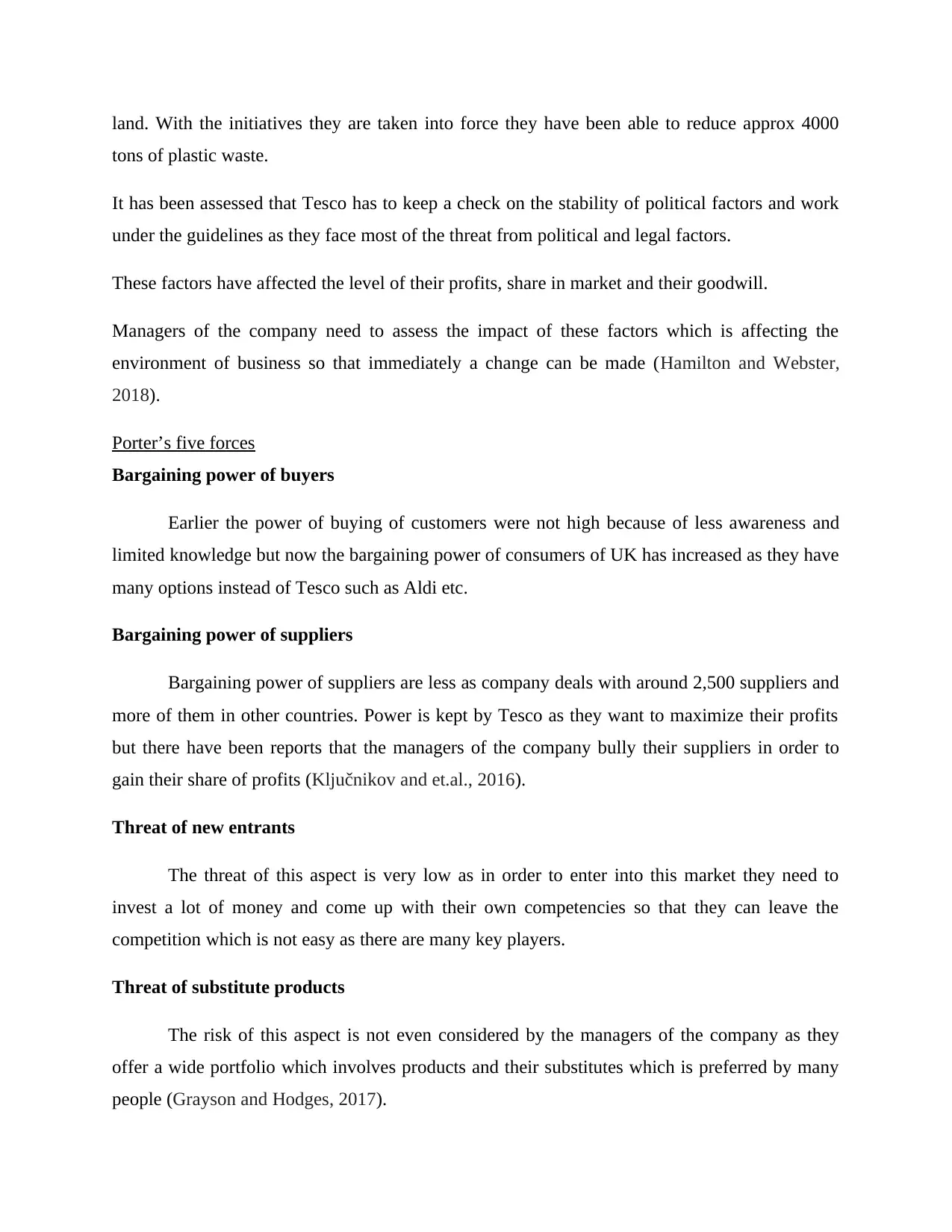
land. With the initiatives they are taken into force they have been able to reduce approx 4000
tons of plastic waste.
It has been assessed that Tesco has to keep a check on the stability of political factors and work
under the guidelines as they face most of the threat from political and legal factors.
These factors have affected the level of their profits, share in market and their goodwill.
Managers of the company need to assess the impact of these factors which is affecting the
environment of business so that immediately a change can be made (Hamilton and Webster,
2018).
Porter’s five forces
Bargaining power of buyers
Earlier the power of buying of customers were not high because of less awareness and
limited knowledge but now the bargaining power of consumers of UK has increased as they have
many options instead of Tesco such as Aldi etc.
Bargaining power of suppliers
Bargaining power of suppliers are less as company deals with around 2,500 suppliers and
more of them in other countries. Power is kept by Tesco as they want to maximize their profits
but there have been reports that the managers of the company bully their suppliers in order to
gain their share of profits (Ključnikov and et.al., 2016).
Threat of new entrants
The threat of this aspect is very low as in order to enter into this market they need to
invest a lot of money and come up with their own competencies so that they can leave the
competition which is not easy as there are many key players.
Threat of substitute products
The risk of this aspect is not even considered by the managers of the company as they
offer a wide portfolio which involves products and their substitutes which is preferred by many
people (Grayson and Hodges, 2017).
tons of plastic waste.
It has been assessed that Tesco has to keep a check on the stability of political factors and work
under the guidelines as they face most of the threat from political and legal factors.
These factors have affected the level of their profits, share in market and their goodwill.
Managers of the company need to assess the impact of these factors which is affecting the
environment of business so that immediately a change can be made (Hamilton and Webster,
2018).
Porter’s five forces
Bargaining power of buyers
Earlier the power of buying of customers were not high because of less awareness and
limited knowledge but now the bargaining power of consumers of UK has increased as they have
many options instead of Tesco such as Aldi etc.
Bargaining power of suppliers
Bargaining power of suppliers are less as company deals with around 2,500 suppliers and
more of them in other countries. Power is kept by Tesco as they want to maximize their profits
but there have been reports that the managers of the company bully their suppliers in order to
gain their share of profits (Ključnikov and et.al., 2016).
Threat of new entrants
The threat of this aspect is very low as in order to enter into this market they need to
invest a lot of money and come up with their own competencies so that they can leave the
competition which is not easy as there are many key players.
Threat of substitute products
The risk of this aspect is not even considered by the managers of the company as they
offer a wide portfolio which involves products and their substitutes which is preferred by many
people (Grayson and Hodges, 2017).
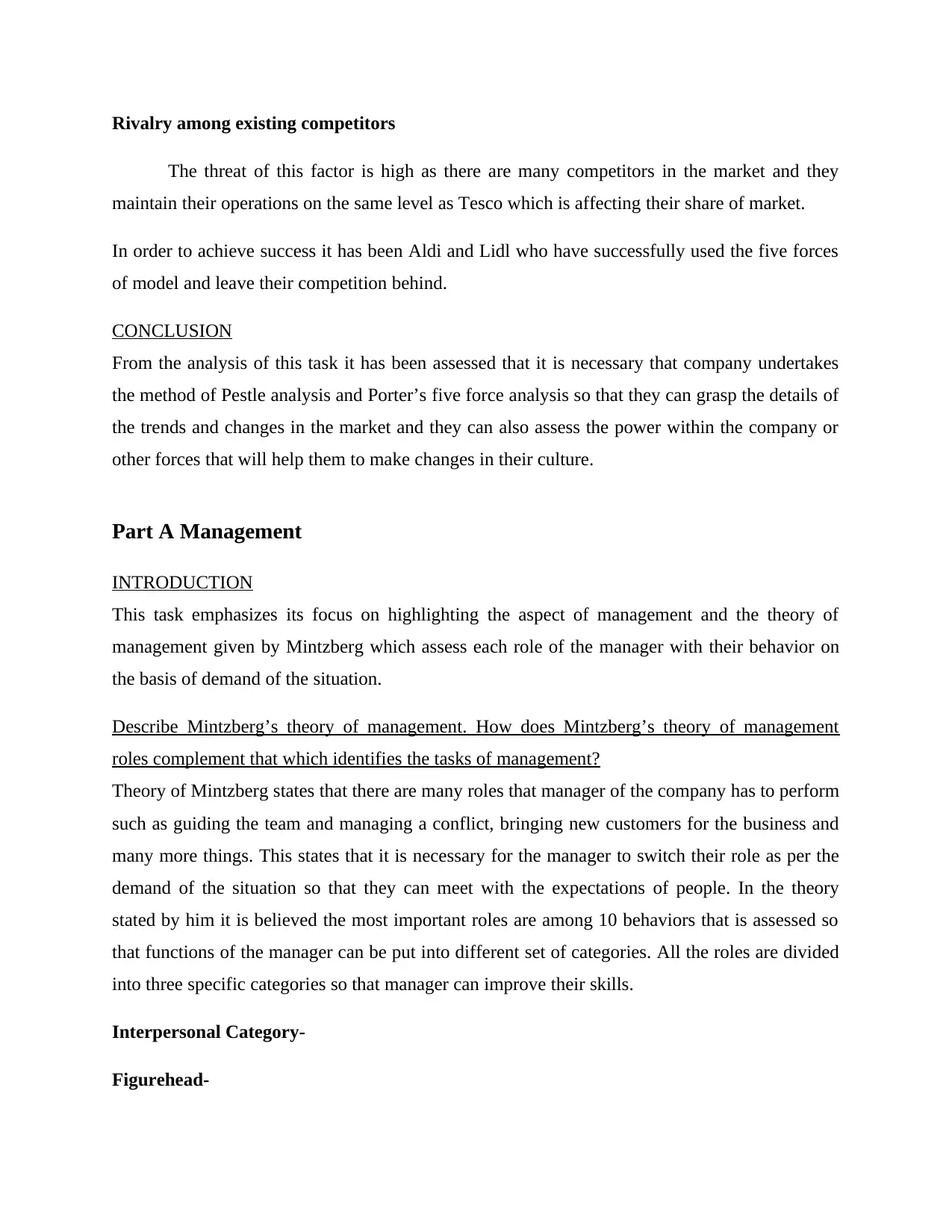
Rivalry among existing competitors
The threat of this factor is high as there are many competitors in the market and they
maintain their operations on the same level as Tesco which is affecting their share of market.
In order to achieve success it has been Aldi and Lidl who have successfully used the five forces
of model and leave their competition behind.
CONCLUSION
From the analysis of this task it has been assessed that it is necessary that company undertakes
the method of Pestle analysis and Porter’s five force analysis so that they can grasp the details of
the trends and changes in the market and they can also assess the power within the company or
other forces that will help them to make changes in their culture.
Part A Management
INTRODUCTION
This task emphasizes its focus on highlighting the aspect of management and the theory of
management given by Mintzberg which assess each role of the manager with their behavior on
the basis of demand of the situation.
Describe Mintzberg’s theory of management. How does Mintzberg’s theory of management
roles complement that which identifies the tasks of management?
Theory of Mintzberg states that there are many roles that manager of the company has to perform
such as guiding the team and managing a conflict, bringing new customers for the business and
many more things. This states that it is necessary for the manager to switch their role as per the
demand of the situation so that they can meet with the expectations of people. In the theory
stated by him it is believed the most important roles are among 10 behaviors that is assessed so
that functions of the manager can be put into different set of categories. All the roles are divided
into three specific categories so that manager can improve their skills.
Interpersonal Category-
Figurehead-
The threat of this factor is high as there are many competitors in the market and they
maintain their operations on the same level as Tesco which is affecting their share of market.
In order to achieve success it has been Aldi and Lidl who have successfully used the five forces
of model and leave their competition behind.
CONCLUSION
From the analysis of this task it has been assessed that it is necessary that company undertakes
the method of Pestle analysis and Porter’s five force analysis so that they can grasp the details of
the trends and changes in the market and they can also assess the power within the company or
other forces that will help them to make changes in their culture.
Part A Management
INTRODUCTION
This task emphasizes its focus on highlighting the aspect of management and the theory of
management given by Mintzberg which assess each role of the manager with their behavior on
the basis of demand of the situation.
Describe Mintzberg’s theory of management. How does Mintzberg’s theory of management
roles complement that which identifies the tasks of management?
Theory of Mintzberg states that there are many roles that manager of the company has to perform
such as guiding the team and managing a conflict, bringing new customers for the business and
many more things. This states that it is necessary for the manager to switch their role as per the
demand of the situation so that they can meet with the expectations of people. In the theory
stated by him it is believed the most important roles are among 10 behaviors that is assessed so
that functions of the manager can be put into different set of categories. All the roles are divided
into three specific categories so that manager can improve their skills.
Interpersonal Category-
Figurehead-
⊘ This is a preview!⊘
Do you want full access?
Subscribe today to unlock all pages.

Trusted by 1+ million students worldwide
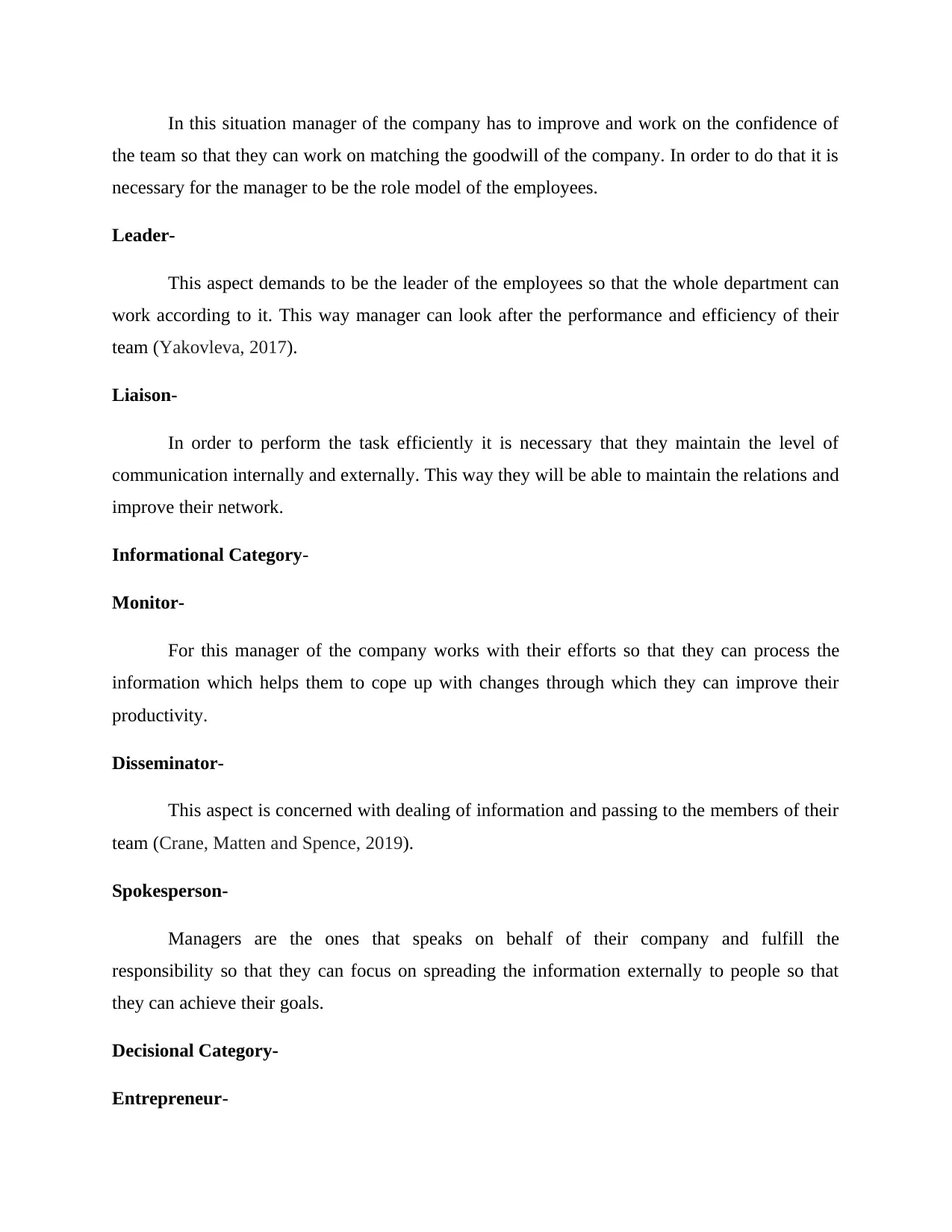
In this situation manager of the company has to improve and work on the confidence of
the team so that they can work on matching the goodwill of the company. In order to do that it is
necessary for the manager to be the role model of the employees.
Leader-
This aspect demands to be the leader of the employees so that the whole department can
work according to it. This way manager can look after the performance and efficiency of their
team (Yakovleva, 2017).
Liaison-
In order to perform the task efficiently it is necessary that they maintain the level of
communication internally and externally. This way they will be able to maintain the relations and
improve their network.
Informational Category-
Monitor-
For this manager of the company works with their efforts so that they can process the
information which helps them to cope up with changes through which they can improve their
productivity.
Disseminator-
This aspect is concerned with dealing of information and passing to the members of their
team (Crane, Matten and Spence, 2019).
Spokesperson-
Managers are the ones that speaks on behalf of their company and fulfill the
responsibility so that they can focus on spreading the information externally to people so that
they can achieve their goals.
Decisional Category-
Entrepreneur-
the team so that they can work on matching the goodwill of the company. In order to do that it is
necessary for the manager to be the role model of the employees.
Leader-
This aspect demands to be the leader of the employees so that the whole department can
work according to it. This way manager can look after the performance and efficiency of their
team (Yakovleva, 2017).
Liaison-
In order to perform the task efficiently it is necessary that they maintain the level of
communication internally and externally. This way they will be able to maintain the relations and
improve their network.
Informational Category-
Monitor-
For this manager of the company works with their efforts so that they can process the
information which helps them to cope up with changes through which they can improve their
productivity.
Disseminator-
This aspect is concerned with dealing of information and passing to the members of their
team (Crane, Matten and Spence, 2019).
Spokesperson-
Managers are the ones that speaks on behalf of their company and fulfill the
responsibility so that they can focus on spreading the information externally to people so that
they can achieve their goals.
Decisional Category-
Entrepreneur-
Paraphrase This Document
Need a fresh take? Get an instant paraphrase of this document with our AI Paraphraser
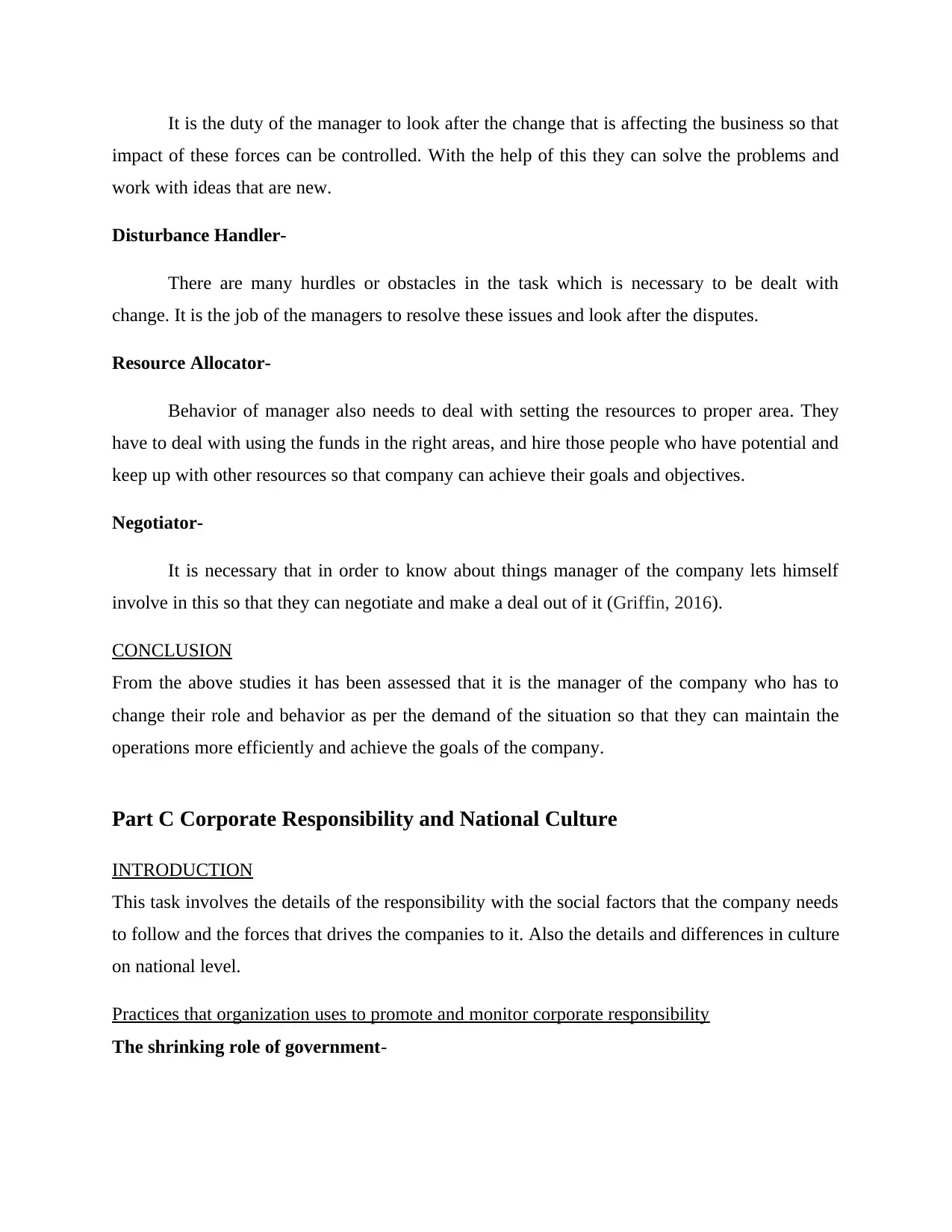
It is the duty of the manager to look after the change that is affecting the business so that
impact of these forces can be controlled. With the help of this they can solve the problems and
work with ideas that are new.
Disturbance Handler-
There are many hurdles or obstacles in the task which is necessary to be dealt with
change. It is the job of the managers to resolve these issues and look after the disputes.
Resource Allocator-
Behavior of manager also needs to deal with setting the resources to proper area. They
have to deal with using the funds in the right areas, and hire those people who have potential and
keep up with other resources so that company can achieve their goals and objectives.
Negotiator-
It is necessary that in order to know about things manager of the company lets himself
involve in this so that they can negotiate and make a deal out of it (Griffin, 2016).
CONCLUSION
From the above studies it has been assessed that it is the manager of the company who has to
change their role and behavior as per the demand of the situation so that they can maintain the
operations more efficiently and achieve the goals of the company.
Part C Corporate Responsibility and National Culture
INTRODUCTION
This task involves the details of the responsibility with the social factors that the company needs
to follow and the forces that drives the companies to it. Also the details and differences in culture
on national level.
Practices that organization uses to promote and monitor corporate responsibility
The shrinking role of government-
impact of these forces can be controlled. With the help of this they can solve the problems and
work with ideas that are new.
Disturbance Handler-
There are many hurdles or obstacles in the task which is necessary to be dealt with
change. It is the job of the managers to resolve these issues and look after the disputes.
Resource Allocator-
Behavior of manager also needs to deal with setting the resources to proper area. They
have to deal with using the funds in the right areas, and hire those people who have potential and
keep up with other resources so that company can achieve their goals and objectives.
Negotiator-
It is necessary that in order to know about things manager of the company lets himself
involve in this so that they can negotiate and make a deal out of it (Griffin, 2016).
CONCLUSION
From the above studies it has been assessed that it is the manager of the company who has to
change their role and behavior as per the demand of the situation so that they can maintain the
operations more efficiently and achieve the goals of the company.
Part C Corporate Responsibility and National Culture
INTRODUCTION
This task involves the details of the responsibility with the social factors that the company needs
to follow and the forces that drives the companies to it. Also the details and differences in culture
on national level.
Practices that organization uses to promote and monitor corporate responsibility
The shrinking role of government-
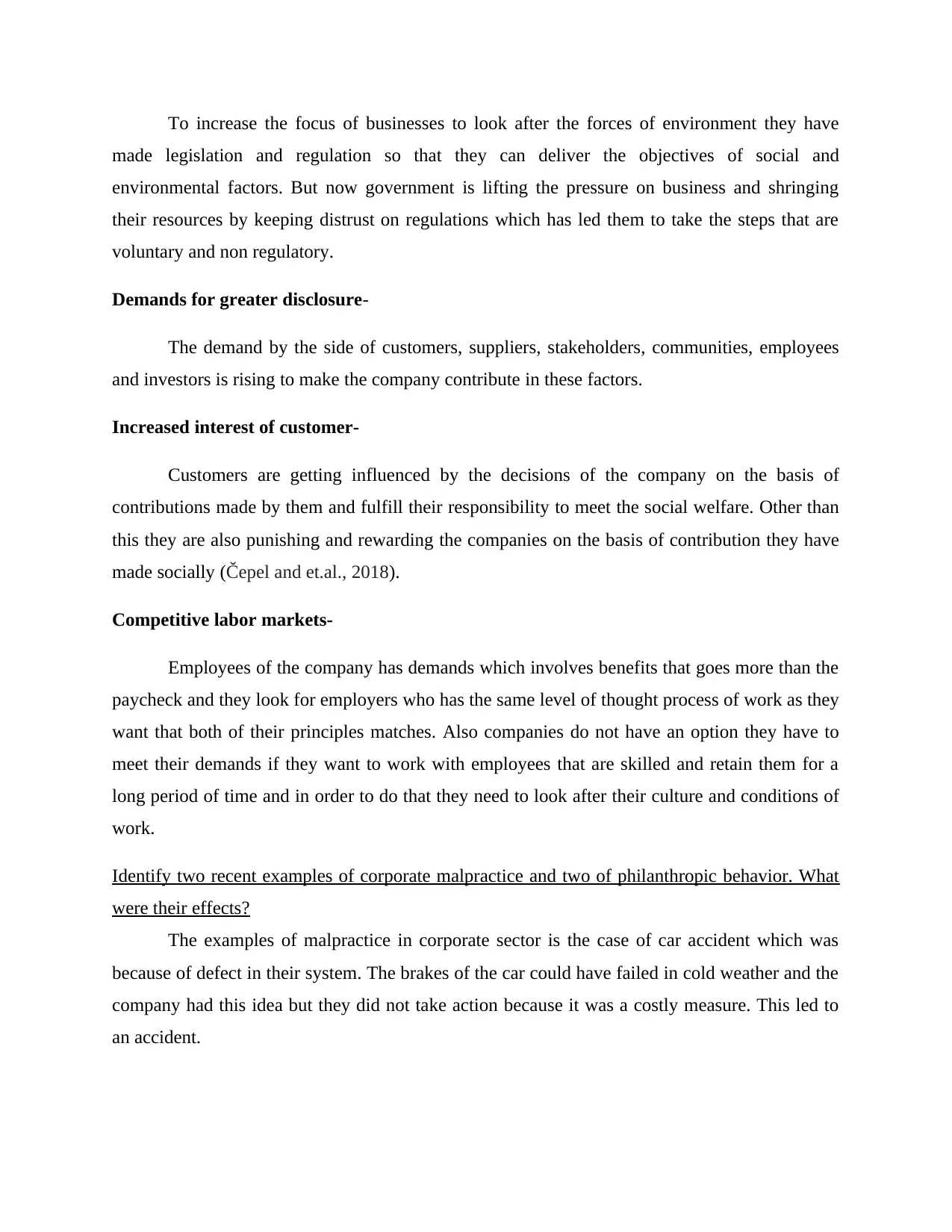
To increase the focus of businesses to look after the forces of environment they have
made legislation and regulation so that they can deliver the objectives of social and
environmental factors. But now government is lifting the pressure on business and shringing
their resources by keeping distrust on regulations which has led them to take the steps that are
voluntary and non regulatory.
Demands for greater disclosure-
The demand by the side of customers, suppliers, stakeholders, communities, employees
and investors is rising to make the company contribute in these factors.
Increased interest of customer-
Customers are getting influenced by the decisions of the company on the basis of
contributions made by them and fulfill their responsibility to meet the social welfare. Other than
this they are also punishing and rewarding the companies on the basis of contribution they have
made socially (Čepel and et.al., 2018).
Competitive labor markets-
Employees of the company has demands which involves benefits that goes more than the
paycheck and they look for employers who has the same level of thought process of work as they
want that both of their principles matches. Also companies do not have an option they have to
meet their demands if they want to work with employees that are skilled and retain them for a
long period of time and in order to do that they need to look after their culture and conditions of
work.
Identify two recent examples of corporate malpractice and two of philanthropic behavior. What
were their effects?
The examples of malpractice in corporate sector is the case of car accident which was
because of defect in their system. The brakes of the car could have failed in cold weather and the
company had this idea but they did not take action because it was a costly measure. This led to
an accident.
made legislation and regulation so that they can deliver the objectives of social and
environmental factors. But now government is lifting the pressure on business and shringing
their resources by keeping distrust on regulations which has led them to take the steps that are
voluntary and non regulatory.
Demands for greater disclosure-
The demand by the side of customers, suppliers, stakeholders, communities, employees
and investors is rising to make the company contribute in these factors.
Increased interest of customer-
Customers are getting influenced by the decisions of the company on the basis of
contributions made by them and fulfill their responsibility to meet the social welfare. Other than
this they are also punishing and rewarding the companies on the basis of contribution they have
made socially (Čepel and et.al., 2018).
Competitive labor markets-
Employees of the company has demands which involves benefits that goes more than the
paycheck and they look for employers who has the same level of thought process of work as they
want that both of their principles matches. Also companies do not have an option they have to
meet their demands if they want to work with employees that are skilled and retain them for a
long period of time and in order to do that they need to look after their culture and conditions of
work.
Identify two recent examples of corporate malpractice and two of philanthropic behavior. What
were their effects?
The examples of malpractice in corporate sector is the case of car accident which was
because of defect in their system. The brakes of the car could have failed in cold weather and the
company had this idea but they did not take action because it was a costly measure. This led to
an accident.
⊘ This is a preview!⊘
Do you want full access?
Subscribe today to unlock all pages.

Trusted by 1+ million students worldwide
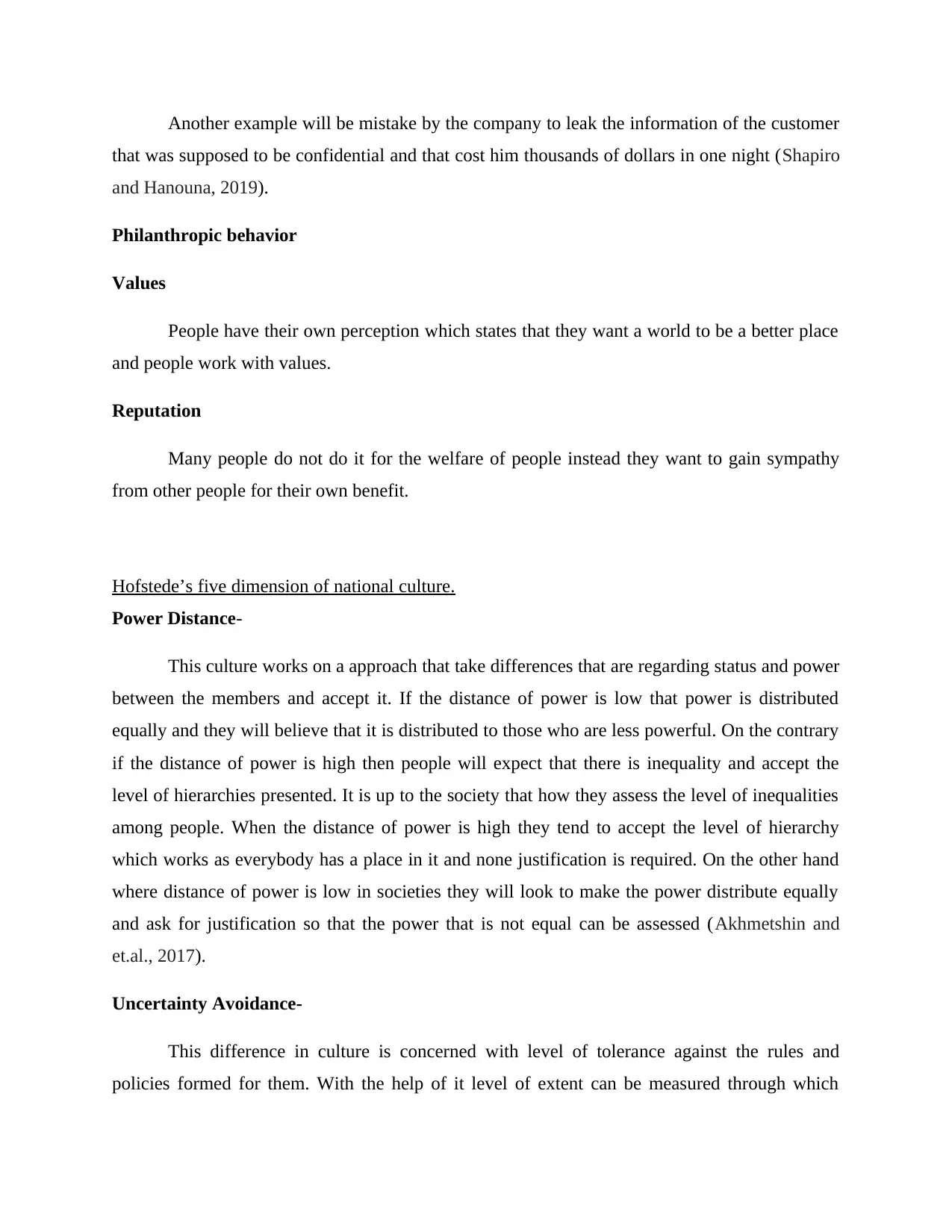
Another example will be mistake by the company to leak the information of the customer
that was supposed to be confidential and that cost him thousands of dollars in one night (Shapiro
and Hanouna, 2019).
Philanthropic behavior
Values
People have their own perception which states that they want a world to be a better place
and people work with values.
Reputation
Many people do not do it for the welfare of people instead they want to gain sympathy
from other people for their own benefit.
Hofstede’s five dimension of national culture.
Power Distance-
This culture works on a approach that take differences that are regarding status and power
between the members and accept it. If the distance of power is low that power is distributed
equally and they will believe that it is distributed to those who are less powerful. On the contrary
if the distance of power is high then people will expect that there is inequality and accept the
level of hierarchies presented. It is up to the society that how they assess the level of inequalities
among people. When the distance of power is high they tend to accept the level of hierarchy
which works as everybody has a place in it and none justification is required. On the other hand
where distance of power is low in societies they will look to make the power distribute equally
and ask for justification so that the power that is not equal can be assessed (Akhmetshin and
et.al., 2017).
Uncertainty Avoidance-
This difference in culture is concerned with level of tolerance against the rules and
policies formed for them. With the help of it level of extent can be measured through which
that was supposed to be confidential and that cost him thousands of dollars in one night (Shapiro
and Hanouna, 2019).
Philanthropic behavior
Values
People have their own perception which states that they want a world to be a better place
and people work with values.
Reputation
Many people do not do it for the welfare of people instead they want to gain sympathy
from other people for their own benefit.
Hofstede’s five dimension of national culture.
Power Distance-
This culture works on a approach that take differences that are regarding status and power
between the members and accept it. If the distance of power is low that power is distributed
equally and they will believe that it is distributed to those who are less powerful. On the contrary
if the distance of power is high then people will expect that there is inequality and accept the
level of hierarchies presented. It is up to the society that how they assess the level of inequalities
among people. When the distance of power is high they tend to accept the level of hierarchy
which works as everybody has a place in it and none justification is required. On the other hand
where distance of power is low in societies they will look to make the power distribute equally
and ask for justification so that the power that is not equal can be assessed (Akhmetshin and
et.al., 2017).
Uncertainty Avoidance-
This difference in culture is concerned with level of tolerance against the rules and
policies formed for them. With the help of it level of extent can be measured through which
Paraphrase This Document
Need a fresh take? Get an instant paraphrase of this document with our AI Paraphraser
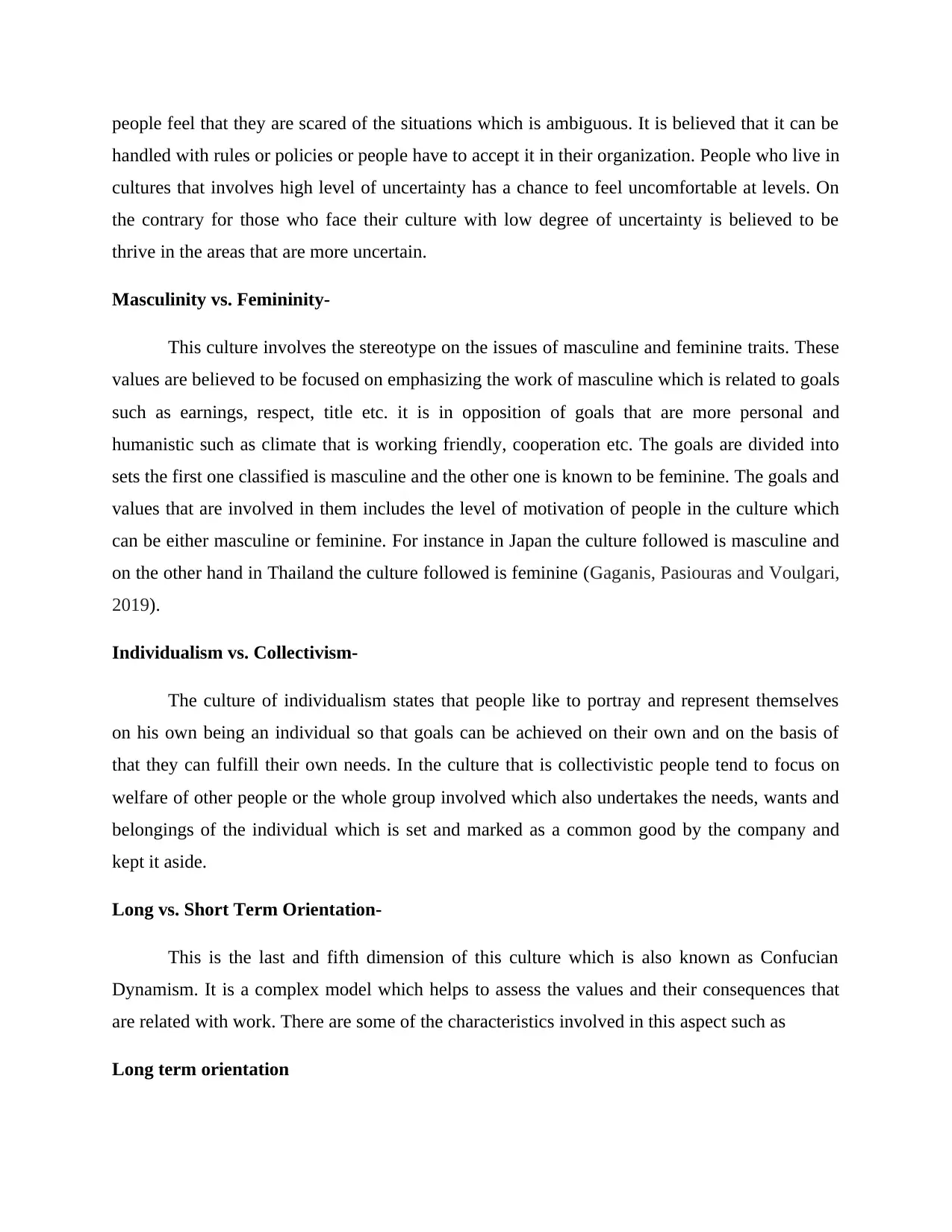
people feel that they are scared of the situations which is ambiguous. It is believed that it can be
handled with rules or policies or people have to accept it in their organization. People who live in
cultures that involves high level of uncertainty has a chance to feel uncomfortable at levels. On
the contrary for those who face their culture with low degree of uncertainty is believed to be
thrive in the areas that are more uncertain.
Masculinity vs. Femininity-
This culture involves the stereotype on the issues of masculine and feminine traits. These
values are believed to be focused on emphasizing the work of masculine which is related to goals
such as earnings, respect, title etc. it is in opposition of goals that are more personal and
humanistic such as climate that is working friendly, cooperation etc. The goals are divided into
sets the first one classified is masculine and the other one is known to be feminine. The goals and
values that are involved in them includes the level of motivation of people in the culture which
can be either masculine or feminine. For instance in Japan the culture followed is masculine and
on the other hand in Thailand the culture followed is feminine (Gaganis, Pasiouras and Voulgari,
2019).
Individualism vs. Collectivism-
The culture of individualism states that people like to portray and represent themselves
on his own being an individual so that goals can be achieved on their own and on the basis of
that they can fulfill their own needs. In the culture that is collectivistic people tend to focus on
welfare of other people or the whole group involved which also undertakes the needs, wants and
belongings of the individual which is set and marked as a common good by the company and
kept it aside.
Long vs. Short Term Orientation-
This is the last and fifth dimension of this culture which is also known as Confucian
Dynamism. It is a complex model which helps to assess the values and their consequences that
are related with work. There are some of the characteristics involved in this aspect such as
Long term orientation
handled with rules or policies or people have to accept it in their organization. People who live in
cultures that involves high level of uncertainty has a chance to feel uncomfortable at levels. On
the contrary for those who face their culture with low degree of uncertainty is believed to be
thrive in the areas that are more uncertain.
Masculinity vs. Femininity-
This culture involves the stereotype on the issues of masculine and feminine traits. These
values are believed to be focused on emphasizing the work of masculine which is related to goals
such as earnings, respect, title etc. it is in opposition of goals that are more personal and
humanistic such as climate that is working friendly, cooperation etc. The goals are divided into
sets the first one classified is masculine and the other one is known to be feminine. The goals and
values that are involved in them includes the level of motivation of people in the culture which
can be either masculine or feminine. For instance in Japan the culture followed is masculine and
on the other hand in Thailand the culture followed is feminine (Gaganis, Pasiouras and Voulgari,
2019).
Individualism vs. Collectivism-
The culture of individualism states that people like to portray and represent themselves
on his own being an individual so that goals can be achieved on their own and on the basis of
that they can fulfill their own needs. In the culture that is collectivistic people tend to focus on
welfare of other people or the whole group involved which also undertakes the needs, wants and
belongings of the individual which is set and marked as a common good by the company and
kept it aside.
Long vs. Short Term Orientation-
This is the last and fifth dimension of this culture which is also known as Confucian
Dynamism. It is a complex model which helps to assess the values and their consequences that
are related with work. There are some of the characteristics involved in this aspect such as
Long term orientation
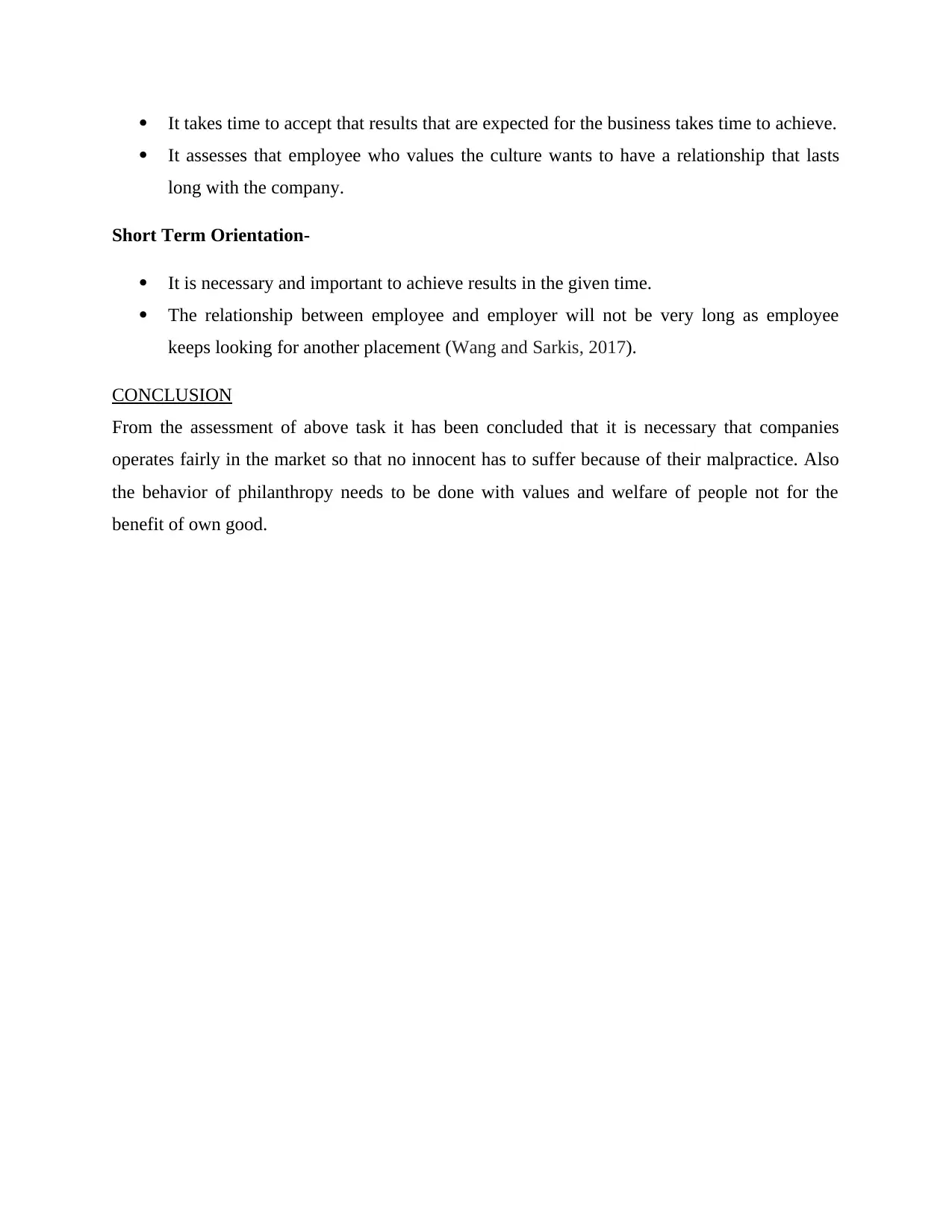
It takes time to accept that results that are expected for the business takes time to achieve.
It assesses that employee who values the culture wants to have a relationship that lasts
long with the company.
Short Term Orientation-
It is necessary and important to achieve results in the given time.
The relationship between employee and employer will not be very long as employee
keeps looking for another placement (Wang and Sarkis, 2017).
CONCLUSION
From the assessment of above task it has been concluded that it is necessary that companies
operates fairly in the market so that no innocent has to suffer because of their malpractice. Also
the behavior of philanthropy needs to be done with values and welfare of people not for the
benefit of own good.
It assesses that employee who values the culture wants to have a relationship that lasts
long with the company.
Short Term Orientation-
It is necessary and important to achieve results in the given time.
The relationship between employee and employer will not be very long as employee
keeps looking for another placement (Wang and Sarkis, 2017).
CONCLUSION
From the assessment of above task it has been concluded that it is necessary that companies
operates fairly in the market so that no innocent has to suffer because of their malpractice. Also
the behavior of philanthropy needs to be done with values and welfare of people not for the
benefit of own good.
⊘ This is a preview!⊘
Do you want full access?
Subscribe today to unlock all pages.

Trusted by 1+ million students worldwide
1 out of 13
Related Documents
Your All-in-One AI-Powered Toolkit for Academic Success.
+13062052269
info@desklib.com
Available 24*7 on WhatsApp / Email
![[object Object]](/_next/static/media/star-bottom.7253800d.svg)
Unlock your academic potential
Copyright © 2020–2025 A2Z Services. All Rights Reserved. Developed and managed by ZUCOL.




